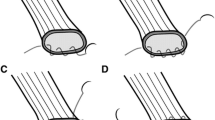Abstract
Background
Performing a safe esophagojejunostomy is important for the standardization of laparoscopic total gastrectomy. We have performed intracorporeal esophagojejunostomy by a circular stapler using the purse-string suturing device that we co-developed. The advantage of this device is that it makes use of the same surgical procedure as open surgery, but it does not depend on the surgeon’s technical skills since this device does not require the laparoscopic hand-sewn technique. Furthermore, we have also adapted this device for double-tract reconstruction after laparoscopic proximal gastrectomy. In this study, we present the surgical procedures and postoperative short-term outcomes that were obtained using this novel technique.
Methods
We enrolled 94 patients that underwent intracorporeal esophagojejunostomy by circular stapler using our device after laparoscopic total or proximal gastrectomy for gastric cancer between November 2009 and October 2016.
Results
Postoperative complications related to esophagojejunostomy were due to anastomotic stenosis in two cases (2.1%) and leakage of the jejunum stump in one case (1.1%).
Conclusions
Intracorporeal esophagojejunostomy by circular stapler using the purse-string suturing device is safe and feasible. This method can be one of the standard procedures for performing intracorporeal esophagojejunostomy.




Similar content being viewed by others
Abbreviations
- LDG:
-
Laparoscopic distal gastrectomy
- LTG:
-
Laparoscopic total gastrectomy
- LPG:
-
Laparoscopic proximal gastrectomy
- PSD:
-
Purse-string suturing device
- EGJ:
-
Esophagogastric junction
References
Kitano S, Iso Y, Moriyama M et al (1994) Laparoscopy assisted Billroth I gastrectomy. Surg Laparosc Endosc 4:146–148
Ohtani H, Tamamori Y, Noguchi K et al (2011) Meta-analysis of laparoscopy-assisted and open distal gastrectomy for gastric cancer. J Surg Res 171:479–485
Katai H, Sasako M, Fukuda H et al (2010) Safety and feasibility of laparoscopic-assisted distal gastrectomy with suprapancreatic nodal dissection for clinical stage I gastric cancer: a multicenter phase II trial (JCOG 0703). Gastric Cancer 13:238–244
Japanese Gastric Cancer Association (2011) Japanese classification of gastric carcinoma: 3rd English edition. Gastric Cancer 14:101–112
Japanese Gastric Cancer Association (2011) Japanese gastric cancer treatment guidelines 2010 (ver. 3). Gastric Cancer 14:113–123
Inaba K, Satoh S, Ishida Y et al (2010) Overlap method: novel intracorporeal esophagojejunostomy after laparoscopic total gastrectomy. J Am Coll Surg 211:e25–29
Yamamoto M, Zaima M, Yamamoto H et al (2014) A modified overlap method using a linear stapler for intracorporeal esophagojejunostomy after laparoscopic total gastrectomy. Hepatogastroenterology 61:543–548
Morimoto M, Kitagami H, Hayakawa T et al (2014) The overlap method is a safe and feasible for esophagojejunostomy after laparoscopic-assisted total gastrectomy. World J Surg Oncol 12:392
Kim HS, Kim MG, Kim BS et al (2013) Comparison of totally laparoscopic total gastrectomy and laparoscopic-assisted total gastrectomy methods for the surgical treatment of early gastric cancer near the gastroesophageal junction. J Laparoendosc Adv Surg Tech A 23:204–210
Nagai E, Ohuchida K, Nakata K et al (2013) Feasibility and safety of intracorporeal esophagojejunostomy after laparoscopic total gastrectomy: inverted T-shaped anastomosis using linear staplers. Surgery 153:732–738
Bracale U, Marzano E, Nastro P et al (2010) Side-to-side esophagojejunostomy during totally laparoscopic total gastrectomy for malignant disease: a multicenter study. Surg Endosc 24:2475–2479
Ebihara Y, Okushiba S, Kawarada Y et al (2013) Outcome of functional end-to-end esophagojejunostomy in totally laparoscopic total gastrectomy. Langenbecks Arch Surg 398:475–479
Tsunoda S, Okabe H, Obama K et al (2014) Short-term outcomes of totally laparoscopic total gastrectomy: experience with the first consecutive 112 cases. World J Surg 38:2662–2667. doi:10.1007/s00268-014-2611-2
Sakuramoto S, Kikuchi S, Futawatari N et al (2010) Technique of esophagojejunostomy using transoral placement of the pretilted anvil head after laparoscopic gastrectomy for gastric cancer. Surgery 147:742–747
Zuiki T, Hosoya Y, Kaneda Y et al (2013) Stenosis after use of the double-stapling technique for reconstruction after laparoscopy-assisted total gastrectomy. Surg Endosc 27:3683–3689
Takiguchi S, Sekimoto M, Fujiwara Y et al (2005) A simple technique for performing laparoscopic purse-string suturing during circular stapling anastomosis. Surg Today 35:896–899
Omori T, Oyama T, Mizutani S et al (2009) A simple and safe technique for esophagojejunostomy using the hemidouble stapling technique in laparoscopy-assisted total gastrectomy. Am J Surg 197:e13–17
Nunobe S, Hiki N, Tanimura S et al (2011) Three-step esophagojejunal anastomosis with atraumatic anvil insertion technique after laparoscopic total gastrectomy. J Gastrointest Surg 15:1520–1525
Usui S, Nagai K, Hiranuma S et al (2008) Laparoscopy-assisted esophagoenteral anastomosis using endoscopic purse-string suture instrument “Endo-PSI (II)” and circular stapler. Gastric Cancer 11:233–237
Lee JH, Ahn SH, Park DJ et al (2012) Laparoscopic total gastrectomy with D2 lymphadenectomy for advanced gastric cancer. World J Surg 36:2394–2399. doi:10.1007/s00268-012-1669-y
Inokuchi M, Otsuki S, Fujimori Y et al (2015) Systematic review of anastomotic complications of esophagojejunostomy after laparoscopic total gastrectomy. World J Gastroenterol 21(32):9656–9665
Author information
Authors and Affiliations
Corresponding author
Ethics declarations
Conflicts of interest
None.
Electronic supplementary material
Below is the link to the electronic supplementary material.
Supplementary material 1 (WMV 121710 kb)
Rights and permissions
About this article
Cite this article
Okuno, K., Gokita, K., Tanioka, T. et al. Esophagojejunostomy Using the Purse-String Suturing Device After Laparoscopic Total or Proximal Gastrectomy for Gastric Cancer. World J Surg 41, 2605–2610 (2017). https://doi.org/10.1007/s00268-017-4033-4
Published:
Issue Date:
DOI: https://doi.org/10.1007/s00268-017-4033-4




